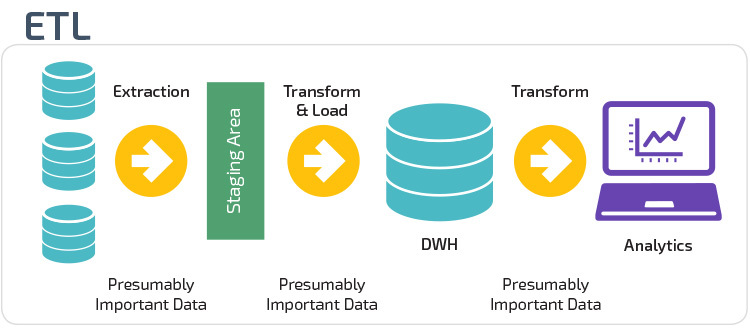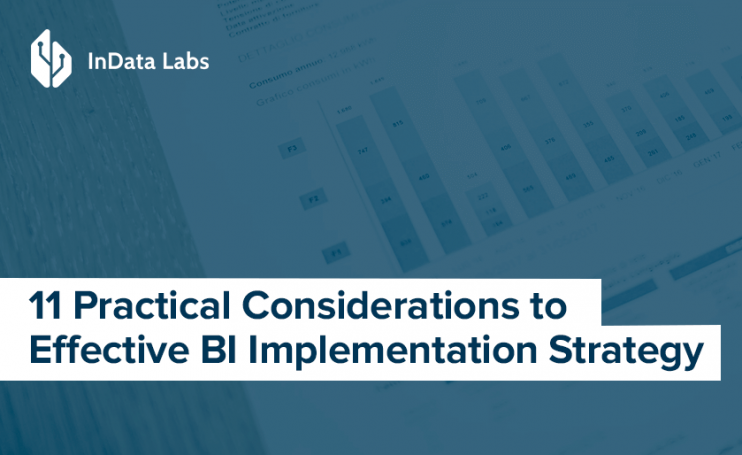Several issues often mar BI implementation, be it technical issues to unclear user requirements to company politics, BI implementation has never been easier for companies.
With so many odds stacked against them, project planning and problem anticipation have become tough even for seasoned BI professionals.
And, unlike smaller companies, BI implementation takes a considerable time for larger companies.
For smaller companies, going by their need for fewer application integration points and less data complexity, BI implementation is faster.
Of the 2500 User Responses Analyzed by the BI Survey, the top three problems cited for BI implementation were software-related issues, unclear user requirements, and a shortage of resources. Not to mention, even training issues were being considered to be the most significant problems.
While developing a strategy for BI implementation, you need to keep the following considerations in mind:
1. BI Implementation is Slow Catalyst
What I mean by ‘slow catalyst’ is that BI implementation doesn’t deliver quick results, be it in terms of data management or automation of processes. Sure enough, BI implementation guarantees results, but it’s slow and gradual. Simply put, the focus of your BI implementation should be long term, especially when it comes to increasing customer base, enhancing customer satisfaction, expansion of existing markets, growing revenue, and so on. Also, before implementing any BI project module, it’s essential to take into account its relevance, consistency, and timeliness.
2. Break down BI Implementation into Manageable Chunks
Breaking BI implementation into manageable steps makes the implementation part easier and helps your project stay on course. Also, project members will feel happier that work is getting done as deliverables are done on an ongoing basis.
With large BI implementation projects, issues such as delayed deliveries occur, as there could be several creases in the project planning that may need to be ironed out. Breaking the project into multiple chunks has several benefits, on the other hand. First, it enables iterative development. Second, constant interaction with project stakeholders will enable us to stay on the correct development course.
Smaller iterations combined with stakeholder feedback will help you to make changes subtly when roadblocks happen.
3. Look for Sponsorship Deals
Getting sponsorships becomes more comfortable if BI implementation is based on business principles. However, a central committee needs to be appointed to keep reviewing the requirements of every department in the organization and also to evaluate the execution process. The IT department should exclusively focus on implementing BI’s technological aspects.
4. Leverage the Right Data
To power a working BI solution, data should be right. For that, it’s crucial to extract the best, useful information from data. Share on X This step should be included in any BI implementation checklist.
Nevertheless, one of the biggest challenges when it comes to implementation of BI is to find the right department for data cleansing – whether it should be the IT team or system owners. The selection of the team should be made on an immediate basis before data starts accumulating.
5. Data Accumulation via ETL Processes
If you are planning to acquire data from online transaction processing (OLTP) for BI implementation, be assured, it would result in delays. However, while creating the extract, transform, and load (ETL) procedures, keep an eye on every field, see how the data is captured, and find update mechanisms for every area.

Source: panoply.io
Every organization has an ‘Excel Jockey,’ who sits on deep piles of data. These sort of data needs to be acquired and standardized by porting several Excel sheets into tables.
If enough efforts are not undertaken to identify such entities, you may have to feed the data mart from your BI stack, which shouldn’t be the case. In fact, it should be the other way round.
More importantly, you need to see if the BI project can execute data mart’s function. This will help cut down the need to own one more application.
6. Continually Validate Data
In the BI space, securing the right data is crucial. You can lose users forever if the data deployed seems inauthentic to them. Keeping an eye on data continually enables you to catch errors, which makes the job easier for QAs. Seek the help of top data warehousing companies to gain access to high-quality data.
7. ETL Is the Nodal Point
Your ETL tool that is your Extract, Transform, and Load tool should be extremely adaptable. If possible, generate a detailed internal training process for this purpose or take outside help. You could also create user manuals and a support mechanism during the initial rollouts.
8. Project Documentation
While undertaking BI implementation, ensure that your project documentation, specifically, the ETL processes are adequately documented. It is of utmost importance to create a knowledge base of all reported issues and used solutions.
9. Get the Team on the Same Page
While accumulating data for BI implementation, make sure the terminologies are in sync across all departments. Different teams may have different versions for the same term. For instance, even a simple word such as ‘purchase’ could evoke different responses from the procurement and finance teams. Since the premise of enterprise BI is to present a single version of the truth, it is essential to have a single version of the terminology.
10. SSBI Makes BI Implementation Pocket-Friendly
Small businesses face cash crunch often, and so implementing BI is the last thing on their minds. However, with the arrival of Self Service Business Intelligence (SSBI) stages, this is not the case anymore. After a few steps, SSBI is open to small businesses on a negligible sum of money.
It’s always recommended that small business with asset limitations should consult BI merchants who would recommend flexible arrangement within your budget. But deterrents get aggravated when too much stress is laid on costly framework speculations expected out of BI programming. So, thanks to the rise of SSBI stages, the cost is no more a business intelligence challenge.
11. Roll out BI in Phases for Every Department
If anything, BI implementation should be carried out in phases and through following right methodologies. Simply put, it should be rolled out to individual departments first. This will help you focus on your resources and even will make the rollout smooth and pleasant. Plus, when the word spreads around about BI’s successful implementation and usefulness, other departments are sure to show more enthusiasm and engagement when their turn comes.
Wrapping Up
Remember, that BI implementation is not a one-time thing. You need to fine-tune it as your business grows and changes continually. And so deploying it in phases will make it all the more effortless.
Author Bio: This is Jennifer Warren, staff writer at GoodFirms – a review and research platform for top ecommerce development companies, digital marketing companies, web development companies among many others.
Work with InData Labs on Your BI Implementation Project
Have a project in mind but need some help implementing it? Drop us a line at info@indatalabs.com, we’d love to discuss how we can work with you.

